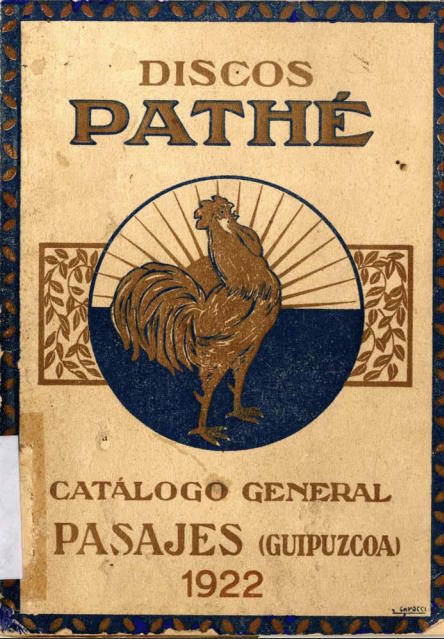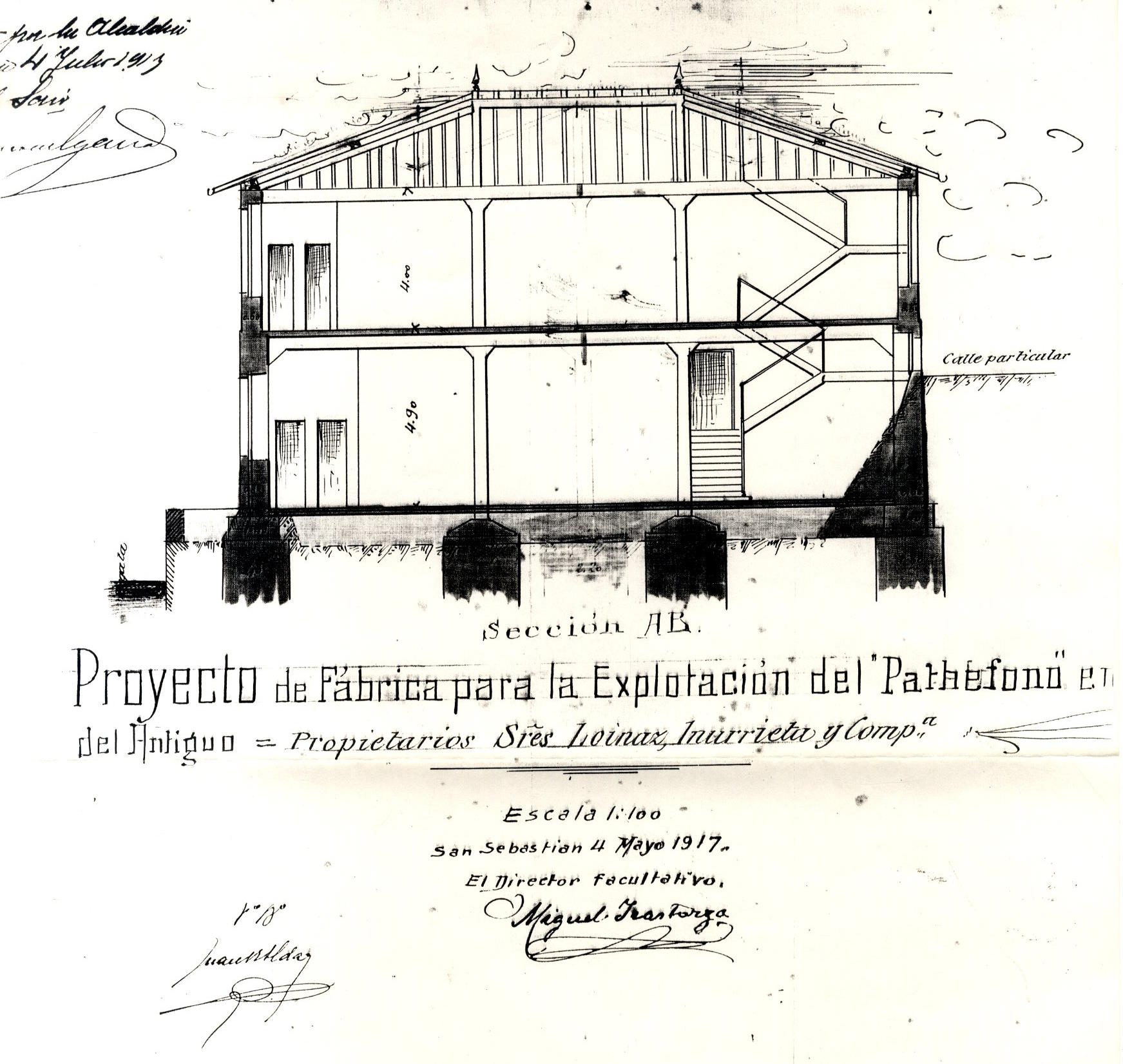
THE FIRST RECORD FACTORY: “PATHÉ”
Salustiano Loinaz Susunaga was born on June 8, 1883. At the age of twenty-five, he established his shop in Irun, where he sold clothing and waterproofs for men and women at 22 San Marcial Street. In 1913, he relocated to San Sebastian with his widowed mother and two younger sisters. He began his business at his residence, 39 Prim Street (1), selling Ernemann Heinrich cameras, bicycles, binoculars, and other items available in installments. By 1915, he had expanded his sales to include “talking machines” and Homokord label records. It’s evident that he had a very similar career trajectory to Juan Inurrieta at this point.
According to the minutes of the Pathé board meetings, which were held on a monthly basis, on December 17, 1915, Émile Pathé presented the idea of granting exclusive exploitation rights in Spain to the company “Pathéphone-Exploitation” under specific conditions that would ensure a satisfactory profit from the sale of records. On January 21, 1916, the meeting minutes documented the agreement with the company “Pathéphone-Exploitation.” This company accepted the monopoly of Pathé products in Spain with the obligation to establish a factory for the production of Pathé records within the country.

Municipal Archives of Pasajes City Council

On February 1, 1916, Mr. Augusto de Aguirre, representing the owner, Mr. Don Juan Insausti, submitted the plans for the construction of the pavilion to the City Council of Pasajes. The plans, dated January 25, 1916, were signed by the owner, Mr. Aguirre, and the lessee, Mr. Loinaz and Co.
The factory was constructed in a hurry. On January 30, 1916, during a plenary session of the local government, an application for this construction was discussed, and several plans by the architect Mr. Aguirre were attached. The minutes noted that “it is a factory for producing records for gramophones and similar devices.” During this session, it was decided to refer the matter to the commission for further consideration. However, clearing and excavation work for the foundations was permitted the following day due to the “urgency of the situation.” The plans were not officially approved until February 6, 1916.

Mundo Gráfico, 30 mayo 1917
Mr. Luis Casares assumed the responsibility of managing the Pathé Font factory. It is suspected that this individual may be the same Mr. Louis Casares who had previously signed a contract to duplicate cylinders using the pantograph copy technique (2) with Pathé Frères in 1899. Luis Casares, originally from Granada, was a mechanic and also engaged in the production of cylinders in the early 20th century. His shop was located at 30 Reyes Católicos Street in Granada. Some cylinders have been discovered bearing the label “Casares mecánico. Granada.” These cylinders were associated with both Luis Casares and A. Casares Aceituno, who operated the Phonographic Great Hall at 3 Puerta Real Street in the same city. Additionally, certain cylinders showed a connection between the two names, as indicated by “A. Casares, impresionado por Luis.” This suggests a potential family relationship between them.
It is known that a Louis Casares worked for the Pathé Firm for several years, specifically in its factory in Chatou, until 1902 when his contract with the company came to an end. It is plausible that the management of the factory in Pasajes was entrusted to a skilled mechanic with experience in the pantograph copying process. While the Pasajes factory didn’t produce cylinders, it focused on creating copies from matrices sent from abroad. These matrices contained recordings made in Paris, Milan, or New York.
In mid-1916, the factory’s operations became more intense, and there was an increased demand for water. On June 20, 1916, the factory’s manager, Mr. Casares, made a request to the council to triple the daily water supply in cubic meters. This request for additional water, as indicated in the report by the city engineer, served two primary purposes: one was for pressing records, and the other was for cooling. The latter activity required substantial quantities of water.
Around the same time, in 1916, S. Loinaz and Co. began promoting a new Pathéphone device with an internal horn and Sapphire diaphragm, branded as “Pathé.” They also introduced double records with diameters of 27 and 29 centimeters under the same brand. In the Spanish and Italian General Catalog of Pathé records for the years 1916-1917, Loinaz was listed as a licensed dealer for installment sales of Pathé records of 27, 29, and 35 centimeters in Spain.
In 1917, the “Explotación española Pathéfono San Sebastián” (3) began to seek agencies across Spain for the sale of their products. In April of that year, Casa Inurrieta, as previously mentioned, was listed as an agency for the sale of Pathé records in San Sebastian. They even advertised the exhibition and sale of Pathé records and devices manufactured in Pasajes at their store, using the title “A new industry in Spain.”
A month earlier, on March 22, 1917, Salustiano Loinaz and Juan Inurrieta had joined forces to purchase a piece of land in the Antiguo district of San Sebastian from Angela and Clemente Balda. Their intention was to construct another factory for the Pathéfono enterprise in San Sebastian. Salustiano owned an undivided third part of this property, which, to the best of our knowledge, he later sold to Andrés Peña on July 22, 1921.
On May 6, 1917, Loinaz, Inurrieta, and Company applied for permission to commence construction of the factory to the City Council of San Sebastian. The project, designed by Miguel Irastorza, specified that the factory would only be used for storage, as indicated in the plans. The building was situated opposite Mr. Kutz’s brewery and was located along the road connecting Benta Berri to Igeldo (4).
The business was thriving, and the expansion of the factory in Pasajes became necessary. On June 4, 1918, a request for the construction of another building in Pasajes, situated between the Pathé factory and the viaduct on 1 de Mayo Street, was submitted to the City Council. The sole promoter in this application was Loinaz and Company. The business was expanding, and new models of devices were introduced that year, such as the Pathéfono “Concert” featuring mahogany furniture and an inside horn.
In 1924, the company underwent a name change, being advertised as the “Sociedad Española del Pathéfono” with a factory in Pasajes, and it transitioned into a public limited company (5).
Regarding their repertoire, in addition to arias from operas, they primarily published zarzuelas, couplets, and dance music for the Spanish market. In June 1917, they announced their latest double-sided 27 cm records, which included recordings by Bella Ninon, tenor Leo Slezak, modern dances (one or two step and foxtrots), waltzes, and national anthems. The July catalogue for that year featured new recordings by La Preciosilla, tenor Icilio Calleja, and Crespo. It also included songs by Bella Ninon and Leo Slezak, violin solos by Rudenyi, and cello solos by Hollmann. In March 1919, they advertised the complete opera “Faust” on 28 double discs in the press.
By 1924, their repertoire included tangos recorded by Francisco Spaventa, songs by Amalia Molina, Encarnita Marzal, and Lolita Méndez, as well as monologues by Mariano Ozores. They also featured dance music by the Tziganes Ibarra Orchestra from the Palace Hotel in Madrid and Lanin’s jazz band. In June of that year, their press advertisements included “La Bejarana” zarzuela, flamenco by La Andalucita and El Canario, Lamoreux Orchestra from Paris, and the Pathé Orchestra. In September, new celebrities were announced: Emma Calve with orchestra, tenor Pierre Lamy, the zarzuela “La canción del olvido,” Milano Band, songs and couplets by Paquita Garzón and Mary La Palmerita. The following month, they advertised some new releases, including recordings by tenor Vara de Rueda, couplets by Cándida Suárez and Blanquita Suárez, Aragonese jotas by Mr. J. Numancia, The Choir of Madrid conducted by Rafael Benedito, whistle solos by Mr. Dionisio Méndez, the Mirecky Orchestra, Infantry Regiment Band no. 38 from Leon, master Francisco Cales, and Milano Band conducted by Ranzato.
It’s worth noting that the recording made by the Pathé Band conducted by Rafael Gascon in 1912 with Aurrescu and Guernicaco arbola (6) is a remarkable exception in this label’s catalog.


The industrial activity in this factory came to an end in 1928 when the Pathé company was acquired by Columbia (7).
The building fell into disrepair and remained in ruins until after the war, when it was renovated and repurposed for the salting industry.
However, Salustiano Loinaz’s business continued to thrive. By 1920, he had already applied for the trademark “Crédito S. Loinaz” for the sale of motorcycles, bicycles, talking machines, and various other products. During this period, he registered several brands of photographic equipment. In 1925, he relocated his shop from Prim Street to France Avenue (Villa Loinaz), where he continued his business operations into the 1930s. Subsequently, he moved his shop to Miguel Imaz Street in the Gros district and later occupied the ground floor of the Equitativa building. There, he focused on the sale of more innovative products, although he still included the sale of records, specifically Regal label records.
(1) Municipal Register of the City of San Sebastian.
(2) Pathé used the pantograph copy method to duplicate lower-quality cylinders, which were sold at a much lower price. See “Casares y la Producción Pantográfica de cilindros Pathé” by Montejano (2005).
(3) Advertisement published in Black and White on March 18, 1917.
(4) These lands, which Salustiano Loinaz later shared with the American Hispanic Society, were expropriated by the City Council of San Sebastian in 1930 for the expansion of the Antiguo district.
(5) In 1924, its name was changed to “Sociedad Española del Pathéfono y de Reproducciones Musicales S.A.” (Source: Jones, Daniel E.; Baró y Queralt, Jaume. La industria musical en Catalunya, 1995).
(6) Considering the catalog number (207), it is likely one of the first records manufactured in 1916 in Pasajes.
(7) The last contribution payment was made in 1929 (Source: City Council of Pasajes).


